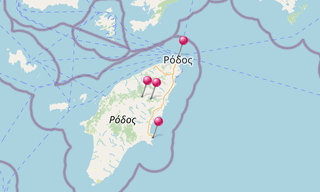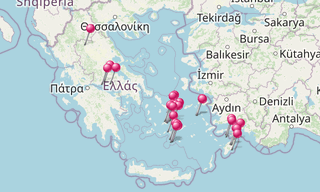Rhodes (Ρόδος) is an island located in the eastern Aegean Sea. It is the largest of the Dodecanese islands in terms of both land area and population. It is located north-east of Crete, south-east of Athens and just off the Anatolian coast of Turkey. Rhodes’ nickname is “The Island of the Knights”.
City of Rhodes
Historically, Rhodes was famous worldwide for the Colossus of Rhodes, one of the Seven Wonders of the Ancient World. The Medieval Old Town of the City of Rhodes has been declared a World Heritage Site by UNESCO.
The city is home to numerous landmarks. Some of them date back to antiquity and most of the others remain from the Knights’ Period.
- Grand Master’s Palace (15th century)
- Knights Street
- Acropolis of Rhodes
- Mosque of Suleiman the Magnificent
- Medieval Walls, created in the mid-14th century on a previous line and remade after the Ottoman siege of 1480 and the earthquake of the following year
- Gothic Buildings in the historical upper town
Lindos
Lindos (Λίνδος) is an archaeological site founded by the Dorians led by the king Tlepolemus of Rhodes, who arrived in about the 10th century BC. It was one of six Dorian cities in the area known as the Dorian Hexapolis. The eastern location of Rhodes made it a natural meeting place between the Greeks and the Phoenicians, and by the 8th century Lindos was a major trading centre. Its importance declined after the foundation of the city of Rhodes in the late 5th century.
In classical times the acropolis of Lindos was dominated by the massive temple of Athena Lindia, which attained its final form in around 300 BC. In Hellenistic and Roman times the temple precinct grew as more buildings were added. In early medieval times these buildings fell into disuse, and in the 14th century they were partly overlaid by a massive fortress built on the acropolis by the Knights of St John to defend the island against the Ottomans.
- The Doric Temple of Athena Lindia, dating from about 300 BC
- The Propylaea of the Sanctuary, also dating from the 4th century BC
- The Hellenistic stoa with lateral projecting wings, dating from about 200 BC
- The relief of a Rhodian trireme (warship) cut into the rock at the foot of the steps leading to the Acropolis
- The Hellenistic staircase (2nd century BC) leading to the main archaeological area of the Acropolis
- Remains of a Roman temple, dedicated to the Emperor Diocletian and dating from about 300 AD.
- The Acropolis is surrounded by a hellenistic wall contemporary with the Propylaea and the stairway leading to the entrance to the site
- The Castle of the Knights of St John, built some time before 1317 on the foundations of older Byzantine fortifications
- The Greek Orthodox Church of St John, dating from the 13th or 14th century and built on the ruins of a previous church
Eleousa
Eleousa (Ἐλεούσα) is a village on the island of Rhodes. In August 1947 the Greek pulmonologist, Emmanuel G. Kostaridis, founded a sanatorium in some of the vacant buildings. The sanatorium was in use thirty-three years, from 1947 to 1970.
Agios Nektarios Kryoneriou
The Agios Nektarios Kryoneriou is a Greek Orthodox monastery and church, located in the interior of the island on the road from the resort of Kolymbia on the mountainside Profitis Ilias approximately two kilometres from the village Archipolis.

-Mandraki-Harbour.hero.landscape.jpg?w=1600)


-Knights-Street.jpg?w=256)
.jpg?w=256)
-Grand-Master%E2%80%99s-Palace.jpg?w=256)
-Old-Town.jpg?w=256)
-Medieval-Walls.jpg?w=256)
-Knights-Street.jpg?w=256)
-Grand-Master%E2%80%99s-Palace.jpg?w=256)
-Medieval-Walls.jpg?w=256)
-Sanatorium.jpg?w=256)
-Old-Town.jpg?w=256)
-Sanatorium.jpg?w=256)
-Agios-Nektarios.jpg?w=256)
-Medieval-Walls.jpg?w=256)
.jpg?w=256)
-Old-Town.jpg?w=256)
-Hellenistic-Stoa.jpg?w=256)
-Sanatorium.jpg?w=256)
-Sanatorium.jpg?w=256)
-Old-Town.jpg?w=256)
-Sanatorium.jpg?w=256)
-Old-Town.jpg?w=256)
-Agios-Nektarios.jpg?w=256)
-Mandraki-Harbour.jpg?w=256)
.jpg?w=256)
-Grand-Master%E2%80%99s-Palace.jpg?w=256)
-Medieval-Walls.jpg?w=256)
-Old-Town.jpg?w=256)
-Medieval-Walls.jpg?w=256)
-Agios-Nektarios.jpg?w=256)
-Medieval-Walls.jpg?w=256)
-Old-Town.jpg?w=256)
-Agios-Nektarios.jpg?w=256)
.jpg?w=256)
.jpg?w=256)
-Old-Town.jpg?w=256)
.jpg?w=256)
-Evreon-Martyron-Square.jpg?w=256)
-Old-Town.jpg?w=256)
-Mandraki-Harbour.jpg?w=256)
-Medieval-Walls.jpg?w=256)
-Knights-Street.jpg?w=256)
-Acropolis-of-Rhodes.jpg?w=256)
-Grand-Master%E2%80%99s-Palace.jpg?w=256)
-Mandraki-Harbour.jpg?w=256)
.jpg?w=256)
-Knights-Street.jpg?w=256)
-Mandraki-Harbour.jpg?w=256)
-Knights-Street.jpg?w=256)
-Sanatorium.jpg?w=256)
-Grand-Master%E2%80%99s-Palace.jpg?w=256)
-Grand-Master%E2%80%99s-Palace.jpg?w=256)
-Grand-Master%E2%80%99s-Palace.jpg?w=256)
-Old-Town.jpg?w=256)
-Agios-Nektarios.jpg?w=256)
-Agio-Georgios.jpg?w=256)
-Old-Town.jpg?w=256)
-Old-Town.jpg?w=256)
-Mandraki-Harbour.jpg?w=256)
-Agio-Triada.jpg?w=256)
-Sanatorium.jpg?w=256)
-Fira.hero.jpg?w=320)

.hero.jpg?w=320)
.map.png)